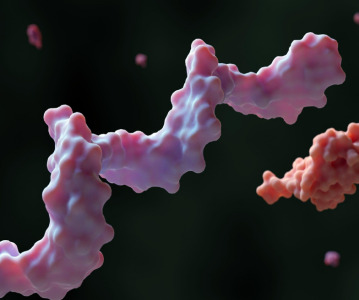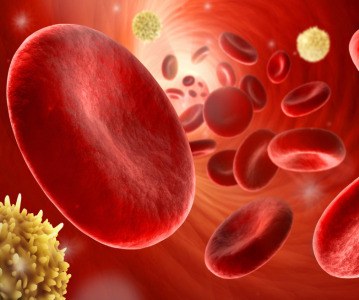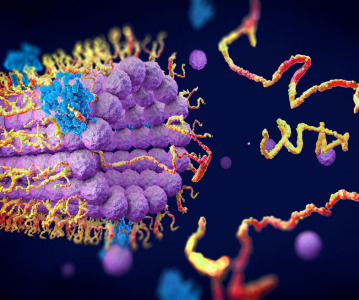NIH Researchers Reveal Link Between Powerful Gene Regulatory Elements and Autoimmune Diseases

Investigators with the National Institutes of Health have discovered the genomic switches of a blood cell key to regulating the human immune system. The findings, published in Nature, open the door to new research and development in drugs and personalized medicine to help those with autoimmune disorders such as inflammatory bowel disease or rheumatoid arthritis.
The senior author of the paper, John J. O’Shea, is the scientific director at NIH’s National Institute of Arthritis and Musculoskeletal and Skin Diseases. The lead author, Golnaz Vahedi is a postdoctoral fellow in Dr O’Shea’s lab in the Molecular Immunology and Inflammation Branch. The study was performed in collaboration with investigators led by NIH Director, Francis S. Collins, in the Medical Genomics and Metabolic Genetics Branch at the National Human Genome Research Institute.
Autoimmune diseases occur when the immune system mistakenly attacks its own cells, causing inflammation. Different tissues are affected in different diseases, for example, the joints become swollen and inflamed in rheumatoid arthritis, and the brain and spinal cord are damaged in multiple sclerosis. The causes of these diseases are not well understood, but scientists believe that they have a genetic component because they often run in families.
“We now know more about the genetics of autoimmune diseases,” said NIAMS Director Stephen I. Katz, “Knowledge of the genetic risk factors helps us assess a person’s susceptibility to disease. With further research on the associated biological mechanisms, it could eventually enable physicians to tailor treatments to each individual.”
Identifying autoimmune disease susceptibility genes can be a challenge because in most cases a complex mix of genetic and environmental factors is involved. Genetic studies have shown that people with autoimmune diseases possess unique genetic variants, but most of the alterations are found in regions of the DNA that do not carry genes. Scientists have suspected that the variants are in DNA elements called enhancers, which act like switches to control gene activities.
Dr O’Shea’s team wondered whether the alterations might lie in a newly discovered type of enhancer called a super-enhancer (SE). Earlier work in the laboratory of Dr Collins and others had shown that SEs are especially powerful switches, and that they control genes important for the function and identity of each individual cell type. In addition, a large number of disease-associated genetic alterations were found to fall within SEs, suggesting that disease occurs when these switches malfunction.
Dr O’Shea’s team began by searching for SEs in T cells, immune cells known to play an important role in rheumatoid arthritis. They reasoned that SEs could serve as signposts to steer them toward potential genetic risk factors for the disease.
“Rather than starting off by looking at genes that we already knew were important in T cells, we took an unbiased approach,” said Dr O’Shea. “From the locations of their super-enhancers, T cells are telling us where in the genome these cells invest their assets — their key proteins — and thereby where we are most likely to find genetic alterations that confer disease susceptibility.”
Using genomic techniques, the researchers combed the T cell genome for regions that are particularly accessible to proteins, a hallmark of DNA segments that carry SEs. They identified several hundred, and further analysis showed that they largely control the activities of genes that encode cytokine and cytokine receptors. These types of molecules are important for T cell function because they enable them to communicate with other cells and to mount an immune response.
But the researchers’ most striking observation was that a large fraction of previously identified alterations associated with rheumatoid arthritis and other autoimmune diseases localized to these T cell SEs. Additional experiments provided further evidence for a central role for SEs in rheumatoid arthritis. When the scientists exposed human T cells to a drug used to treat the disease, tofacitinib, the activities of genes controlled by SEs were profoundly affected compared to other genes without SEs. This result suggests that tofacitinib may bring about its therapeutic effects in part by acting on SEs to alter the activities of important T cell genes.
“Three types of data — the genetics of rheumatoid arthritis, a genomic feature of T cells, and the pharmacological effects of a rheumatoid arthritis drug — are all pointing to the importance of super-enhancers,” said Dr Vahedi. “These regions are where we plan to search for insights into the mechanisms that underlie rheumatoid arthritis and other autoimmune diseases, and for novel therapeutic targets for these conditions.”
Related News
-
News Google-backed start-up raises US$600 million to support AI drug discovery and design
London-based Isomorphic Labs, an AI-driven drug design and development start-up backed by Google’s AI research lab DeepMind, has raised US$600 million in its first external funding round by Thrive Capital. The funding will provide further power t... -
News AstraZeneca to invest US$2.5 billion in Beijing R&D centre
Amid investigations of former AstraZeneca China head Leon Wang in 2024, AstraZeneca have outlined plans to establish its sixth global strategic R&D centre in China. Their aim is to further advance life sciences in China with major research and manufact... -
News Experimental drug for managing aortic valve stenosis shows promise
The new small molecule drug ataciguat is garnering attention for its potential to manage aortic valve stenosis, which may prevent the need for surgery and significantly improve patient experience. -
News How GLP-1 agonists are reshaping drug delivery innovations
GLP-1 agonist drug products like Ozempic, Wegovy, and Mounjaro have taken the healthcare industry by storm in recent years. Originally conceived as treatment for Type 2 diabetes, the weight-loss effects of these products have taken on unprecedented int... -
News A Day in the Life of a Start-Up Founder and CEO
At CPHI we work to support Start-Up companies in the pharmaceutical industry and recognise the expertise and innovative angles they bring to the field. Through our Start-Up Programme we have gotten to know some of these leaders, and in this Day in the ... -
News Biopharmaceutical manufacturing boost part of new UK government budget
In their national budget announced by the UK Labour Party, biopharmaceutical production and manufacturing are set to receive a significant boost in capital grants through the Life Sciences Innovative Manufacturing Fund (LSIMF). -
News CPHI Podcast Series: The power of proteins in antibody drug development
In the latest episode of the CPHI Podcast Series, Lucy Chard is joined by Thomas Cornell from Abzena to discuss protein engineering for drug design and development. -
News Amgen sues Samsung biologics unit over biosimilar for bone disease
Samsung Bioepis, the biologics unit of Samsung, has been issued a lawsuit brought forth by Amgen over proposed biosimilars of Amgen’s bone drugs Prolia and Xgeva.
Position your company at the heart of the global Pharma industry with a CPHI Online membership
-
Your products and solutions visible to thousands of visitors within the largest Pharma marketplace
-
Generate high-quality, engaged leads for your business, all year round
-
Promote your business as the industry’s thought-leader by hosting your reports, brochures and videos within your profile
-
Your company’s profile boosted at all participating CPHI events
-
An easy-to-use platform with a detailed dashboard showing your leads and performance







.png)